A famous Naim for 40 years
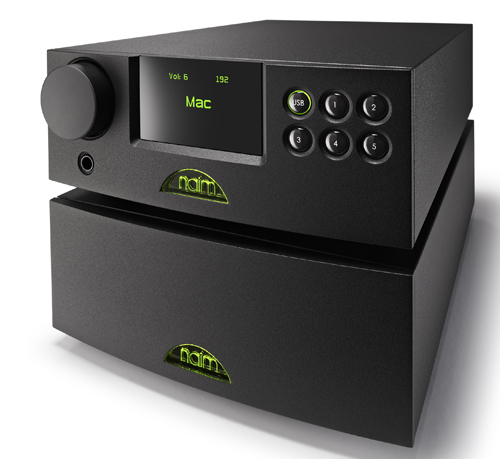
One of Britain's best-known and most successful hi-fi companies has just hit the big Four-O.
It was 40 years ago this week that Julian Vereker founded Naim Audio, and today the company has sales of €17.5m, double-digit year-on-year growth, is a partner in an operation with sales in excess of €60m – and also happens to make some seriously desirable hi-fi equipment.
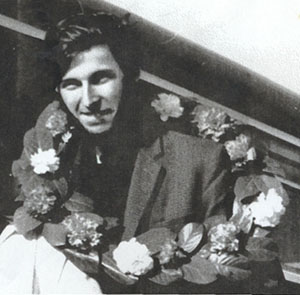
Today Naim may be best-known to more people as the maker of the Uniti range of network music products, but it's remained true to its roots: then in his early 20s and a successful racing driver and engineer – his speciality was super-tuned Minis –, Vereker (left) started experimenting with his own amplifier designs out of a dissatisfaction with the way recordings he made of musician friends sounded.
And music is still very much at the heart of what Naim does, from the entry-level UnitiQute and the DAC-V1 at the top of this page, to its full-blown multi box active systems based around its flagship Ovator S-800 speakers and a rack (or two) of black boxes.
In fact, Vereker's first products – even before Naim existed as a company – were as innovative as the Uniti range seemed when it appeared a few years back.
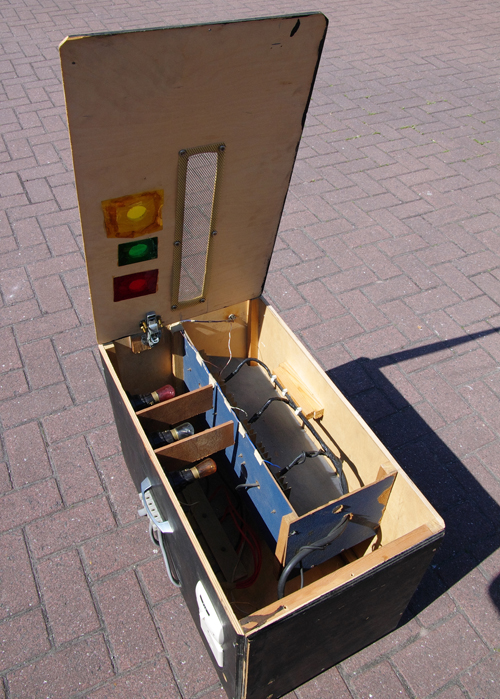
He built the 'does what it says on the tin' Sound to Light box (above), able to switch 30kW of lighting in time to music, in 1969, and in 1972 designed the NAM 502, combining a compact version of his amplifier design with speaker drivers in a single cabinet.

The client? Newly-founded London independent radio station Capital Radio, then just setting itself up ahead of its launch the next year, bringing the city a service including a breakfast show memorably presented by Kenny Everett and Dave Cash.
The latest hi-fi, home cinema and tech news, reviews, buying advice and deals, direct to your inbox.
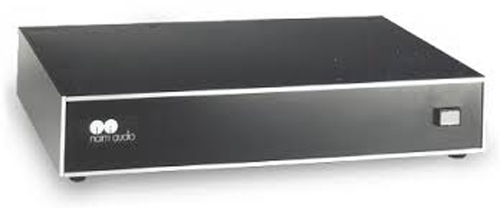
On June 4th, 1973 the company was formally incorporated as Naim Audio Ltd. Located in the centre of Salisbury, the city where the company's products are still made 40 years later, it soon launched its first commercial product, the NAP 200 power amplifier, using a Vereker design from a couple of years previously.
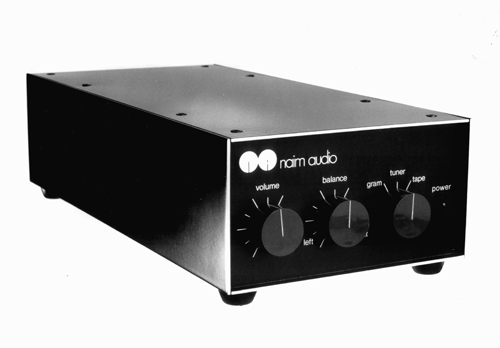
The famous Naim black boxes – albeit with the 'chrome bumper' strip around the edge of the enclosure – had arrived, and soon came the shoebox-shaped NAC 12 preamplifier, the first of many 'small boxes' from Naim, to partner the NAP 200.
At the time, the widely-held belief was that the sound of a system was determined by the speakers, and that amplifiers should be no more than 'a straight wire with gain' – a means to an end in doing no more than driving the speakers.
Vereker disagreed, in characteristically forthright fashion, and hot on the heels of the NAP 200 was the NAP 250 power amp of 1975, encapsulating his view of how an amplifier should be designed, and destined to set the pattern for all Naim power amps for the next quarter of a century.
CD not good enough
In fact, flying in the face of perceived wisdom and 'doing their own thing' has been the way Naim and its engineers have always worked: they engineered products they'd want to listen to, rather than following the pack. That's one reason why, for example, Naim was a late adopter of CD: although the format had been launched in 1982, throughout the 1980s Naim felt the sound of CD was inferior to that available from LPs – not just the player technology, but the way the music was transferred to disc – and it wasn't until 1990 that it made the move into CD.
More of that in a moment, but also apparent throughout the 1980s was that Naim was growing fast, and keen to make its presence felt. It built up a network of loyal dealers, had already moved in 1980 to a 1000 sq m factory on the outskirts of Salisbury – where it's still located, and still expanding – and launched a range of attention-grabbing adverts in the hi-fi press.

With plays on the name of the company – 'Make a note of our Naim' had a chrome-bumper power amp replacing one of the black keys on a keyboard, while 'I'm sorry, I didn't catch your Naim' and 'You're nobody without a Naim' both took a tongue in cheek approach – the ads became something of a trademark.
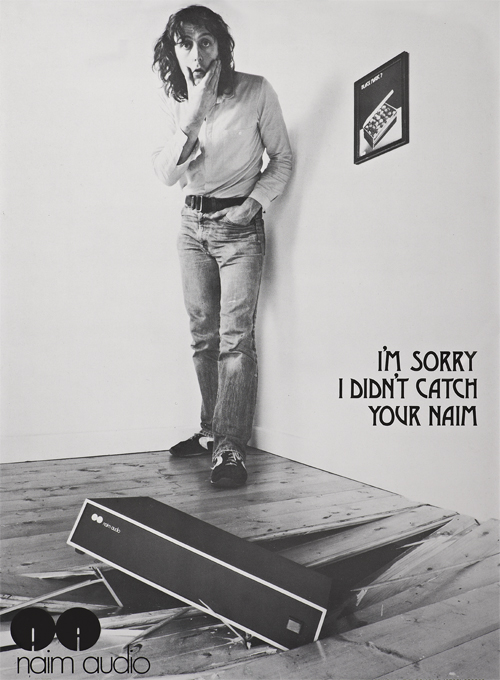
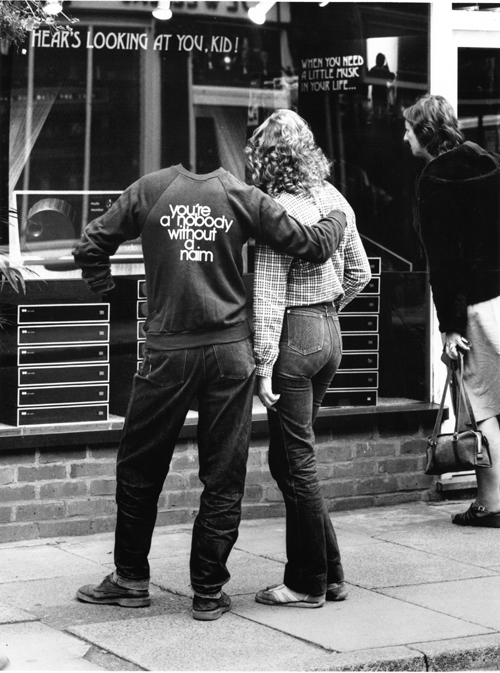

Vereker himself appeared in an ad for the company's first integrated amp, the Nait, in 1983, stealing a line from the Mr Kipling cake ads of the time, while in the early 1990s, as Naim finally got onboard with CD, he'd make another appearance, this time in colour, to launch the Naim Label.
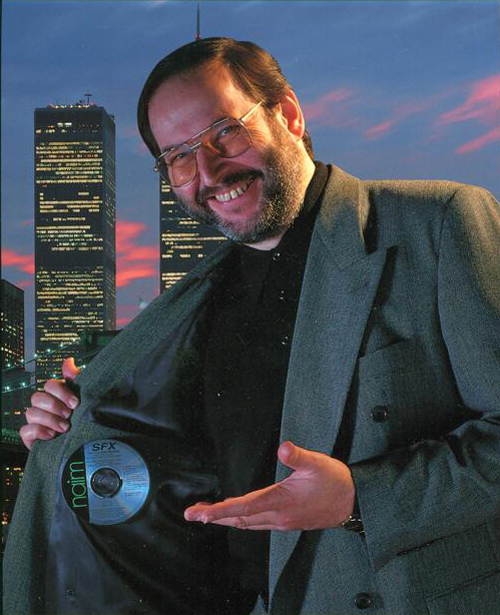
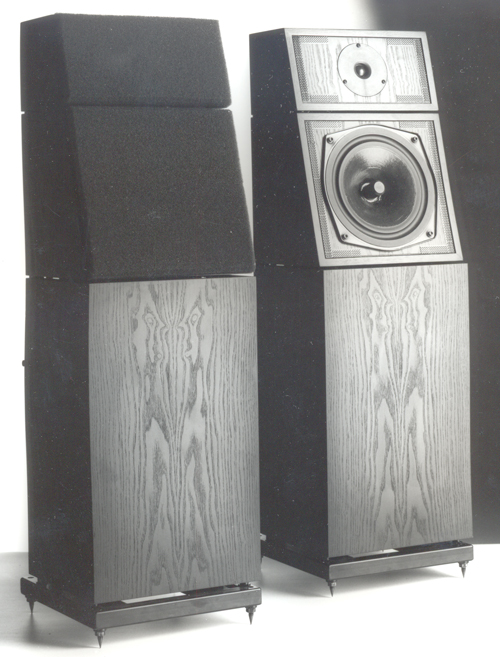
In the meantime, Naim had launched its NA SBL speaker in 1985, using a unique three-box design some – even seasoned reviewers – struggled to assemble and get sounding right. But when it sounded right, driven by a full-house Naim system, it was (and still is) something special. If not the prettiest speaker solution you will ever see, admittedly
But not all Naim projects were such a success: in the mid-1980s Naim explored an electrostatic speaker design, the FL 1, developed by Frenchman Guy Lamotte, hired by Vereker as chief designer at Naim. He was behind the company's classic NAT 01 FM tuner among other products, and built the FL 1 to solve some of the problems he saw in the Quad ESL 57 speaker, which he loved, but thought too fragile: his design had a rather more 'industrial' build quality.
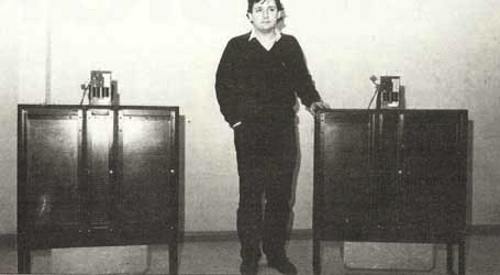
Plans were in place to launch the speakers in 1987, but Lamotte – seen above with the speakers – wasn't too happy living in England (as you might have gathered from the picture). He left both the company and the country before the design was finished.
Eventually the project was abandoned, Naim deciding to stick to conventional – well, fairly conventional – speakers instead.
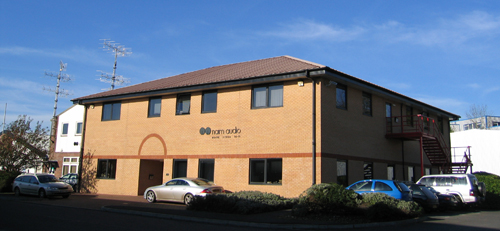
Along the way it had doubled the size of the factory to nearly 2000 sq m to meet demand for its products, and picked up a Queen's Award for Export – both in 1985 -, and would go on to acquire an adjacent site and build what is now the R&D and admin departments, thus freeing up more space for production, in 1994.
Here's a video of how Naim's manufacturing looked back in 1989
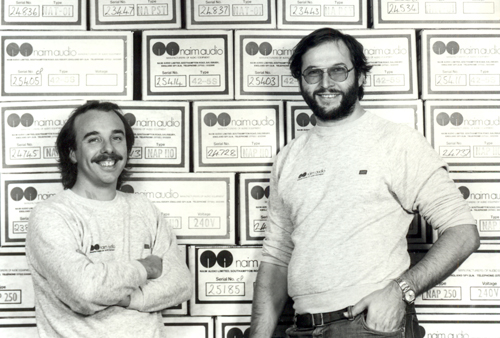
Current MD Paul Stephenson had joined in 1981 from hi-fi retail, and is seen here celebrating the 1985 Queen's Award with Vereker. 25 years later he would accept a second Queen's Award for Export on behalf of Naim.

Meanwhile Vereker was still indulging his interest in all things engineering by becoming a director of start-up folding bike company Brompton Bicycles.
He underwrote the bank loan enabling founder and designer Andrew Ritchie to start production in Brentford, West London, and today Brompton is Britain's biggest bicycle manufacturer, making some 22,000 folding bikes a year.
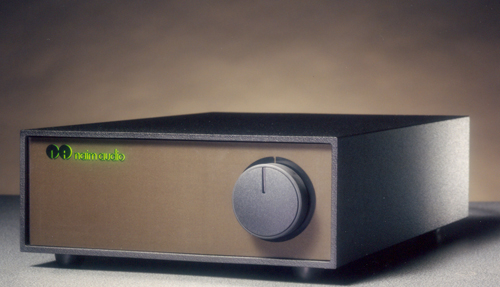
In 1989, the styling of Naim products changed from the original 'chrome bumpers' to the more modern 'olive' look, which in turn later gave way to an all-black, finally adopting the styling of the current Naim range heralded by the NAP 500 power amplifier.

1989 also saw the arrival of the ARO unipivot tonearm, with the entire 'bearing' comprising a spike sitting in a cup atop the pillar. It uses an extremely rigid arm-tube, and for a long time visitors were told 'if you can bend the tube with your hands, we'll give you an ARO'. It remained in the Naim catalogue for over 20 years.

But back to CD, and in 1991 Naim reckoned the quality of CD transfers and the digital technology available to play them – was good enough to stick its toe in the digital waters. Some toe: the CDS (above) was a massive top-loading two-box CD player. OK, so two-box players weren't new – the transport and DAC thing was already in full swing – but Naim's second box wasn't a DAC, but a power supply.
Why? Naim thinking again: the best place for the DAC was kept close to the disc-reading mechanism, while the best place for the power supply was away from the delicate electronics, and built to do just one job, which was passing clean power to the various sections of the player while keep any mains noise well away.

This two-box route will be familiar to Naim fans: all but the least expensive products in its mainstream range can be upgraded with the addition of off board power supplies, while the flagship models, such as the NAC 552 preamp, CD555 CD player (above) and NDS network music player, have no onboard power supply, and need to be used with an offboard one.
Or two, sometimes…
That's one of those Naim things, of which the most famous is perhaps its use of locking DIN connections when just about the rest of the world uses phono plugs and sockets. Why? Simply because it thinks they sound better: even though modern Naim equipment does have phono inputs purely for customer convenience, the DIN sockets – and the cables for them – are preferred.
And in case you were wondering why Naim's sockets tend to be a bit wobbly, while those on other products are rock-solid, that's for an engineering reason too, the Naim engineers saying that decoupling the sockets from the casework keeps more vibration away from the delicate electronics.
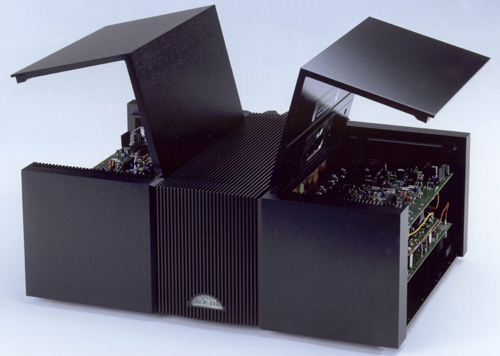
The NAP 500 power amplifier, the beginning of a new Nam reference series, a completely new circuit design and featuring the styling now seen across the range, was launched in 2000, the same year that Julian Vereker died, aged just 54.
I remember driving down to Salisbury for his memorial service, expecting a sombre occasion attended by friends, colleagues and even some rivals from the hi-fi industry: what we got instead was a moving, and at times very entertaining, event very much in the Vereker spirit.
Another memorable trip down to the factory saw me in a new building beside the factory, inside which sat a rather dusty Bentley: this was the test-bed for the Naim for Bentley project, which came to fruition with the launch of an optional upgrade sound system for the Crewe-built luxury cars in 2008.

Here's our video review of the Naim for Bentley system
Extensive work in DSP and other technologies was needed to meet the needs of the system – work which has since found uses in other Naim products – but the pay-back was a degree of customer acceptance surpassing expectations. Even Bentley seemed surprised just how many people were ticking that box on the order form!

The other landmark Naim moment for me was the launch of the NaimUniti – a completely revolutionary product from Salisbury, and one putting it ahead of the whole network music streaming game.
After all, the company had held back on CD until it was right, had only ever made one 'all-in-one' system before – the n-Vi – and was about as far as you could imagine from the whole MP3s'n'iPods image of computer-stored music as it was then, back at the end of the Noughties.

It had announced the HDX (above) the year before – a networked music player/ripper/store – , and already had products able to store and stream music as part of its NaimNet sub-brand, mainly aimed at the custom installation market, but it was with the arrival of the NaimUniti that things began to fall into place.
Its 2009 launch had many in the industry shaking their heads, mutterings from the loyal fanbase along the lines of 'Has Naim lost its way?' and 'What would Julian have said?', and curses from sub-editors the third time you explained that yes, it was called the NaimUniti, yes, it was one word with a second capital letter in the middle, and no, it wasn't the Naim NaimUniti.
Just over four years ago, having picked up one of the first NaimUniti samples – notice how I avoided the NaimUnities/NaimUnitis/NaimUnitii thing there? – from the factory and then having lost a weekend playing with it, I wrote the first hand-on review of the product.
It was in our The next big thing section, and at the time I suggest it was capable of 'rearranging the way you listen': as the streaming trend has grown, and the Uniti range has developed and expanded, spinning off into the ND line-up of network music separates along the way, the Naim production facility has been kept busy keeping up with demand for the systems.
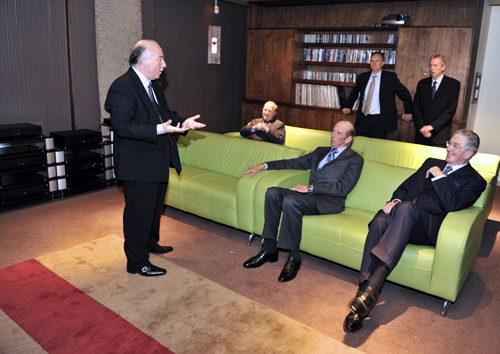
It picked up its second Queen's Award for Export in 2010 – that's Paul Stephenson above, demonstrating Naim's listening room to HRH The Duke of Kent (front row, centre) at the time of the presentation – and now has streaming products from the UnitiQute 2 all the way up to the NDS (below), and has still found time to keep its 'mainstream' hi-fi range growing, for example with the launch of the Ovator S-800 speakers last year.
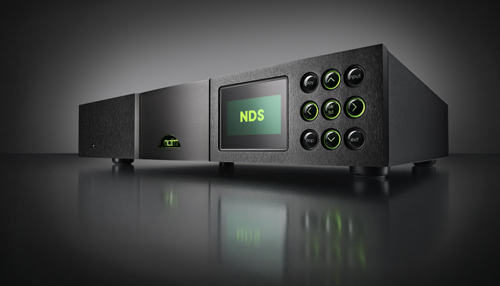
After all, streaming products may now be 30% of the company's business through its 750 retailers worldwide – not bad from a standing start just four years ago – but that still means 70 % of its sales come from conventional players, amplifiers and speakers.
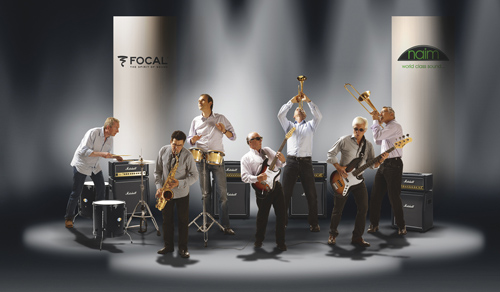
Naim merged with French speaker company Focal in 2011, creating a much larger group with extended resources for research and development. The only slightly bizarre picture above, released at the time of the deal, shows Paul Stephenson front and centre on lead guitar, flanked by Focal MD Gérard Chrétien on sax and Focal-JMlab founder Jacques Mahul on bass.
Naim technical director Roy George – a 28-year company veteran and described as the keeper of the Naim sound – is far left; here he explains the Naim philosphy of audio and listening.
The balance of the staff at Naim HQ has changed over the years, although there's still the highly experienced assembly workforce, the longest-serving of whom has been with the company for almost the whole 40 years. They handbuild and test every Naim product, from the most complex network music player all the way down to cables.
However, there's also a fast-growing emphasis on R&D, with over 20% of the 150-strong team now working on new products and further developing the current ones.
What's more, over 70% of the sales from its record company, The Naim Label, are high-definition downloads, and over 60% of the music available is offered in high-definition.
So where does Naim go from here? Well, it's a little tight-lipped at the moment, saying only that 'the next five years will see innovative, ground-breaking product development all aligned to our core values of raising the performance of high-fidelity in the home.'
I get the impression at least some of those products may not be that far down the line...
MORE: Read all our Naim reviews
Written by Andrew Everard
Andrew has written about audio and video products for the past 20+ years, and been a consumer journalist for more than 30 years, starting his career on camera magazines. Andrew has contributed to titles including What Hi-Fi?, Gramophone, Jazzwise and Hi-Fi Critic, Hi-Fi News & Record Review and Hi-Fi Choice. I’ve also written for a number of non-specialist and overseas magazines.
